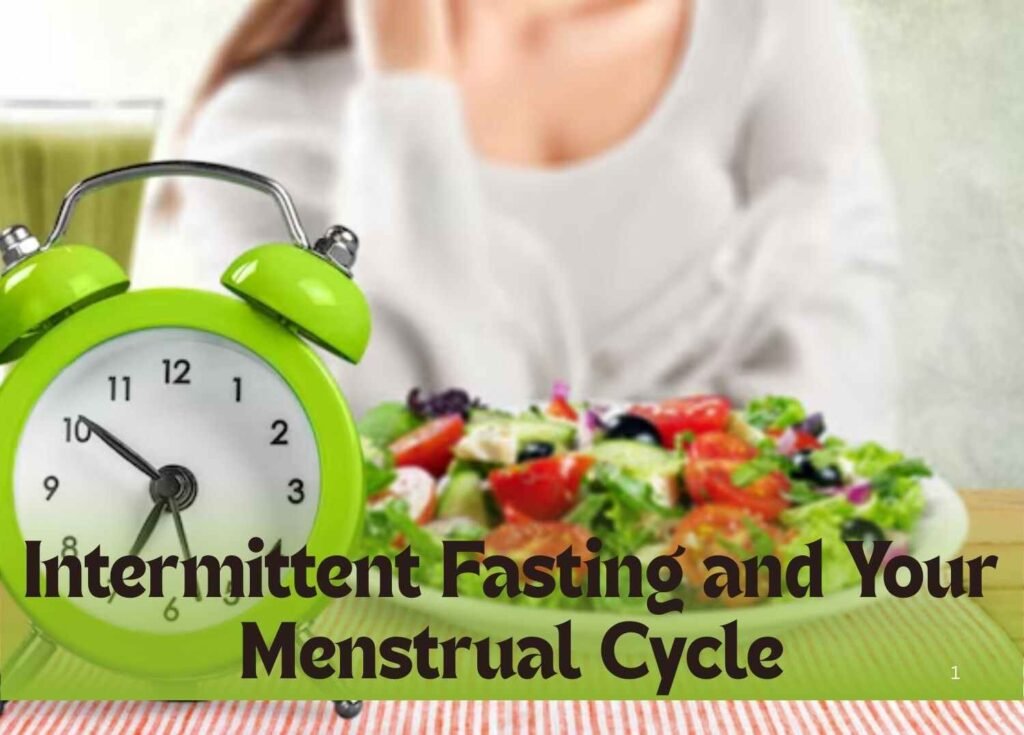Role of Intermittent Fasting during the Menstrual Cycle
Hormonal fluctuations throughout the menstrual cycle influence energy levels, hunger cues, and even mood swings, making it essential to adjust your fasting approach accordingly. The menstrual cycle isn’t just about periods; it’s a complex interplay of reproductive hormones that impacts everything from insulin sensitivity to fat storage. Intermittent Fasting and Your Menstrual Cycle are deeply linked; understanding that connection can transform how fasting feels and functions for a woman’s body. The key is to work with your cycle, not against it.
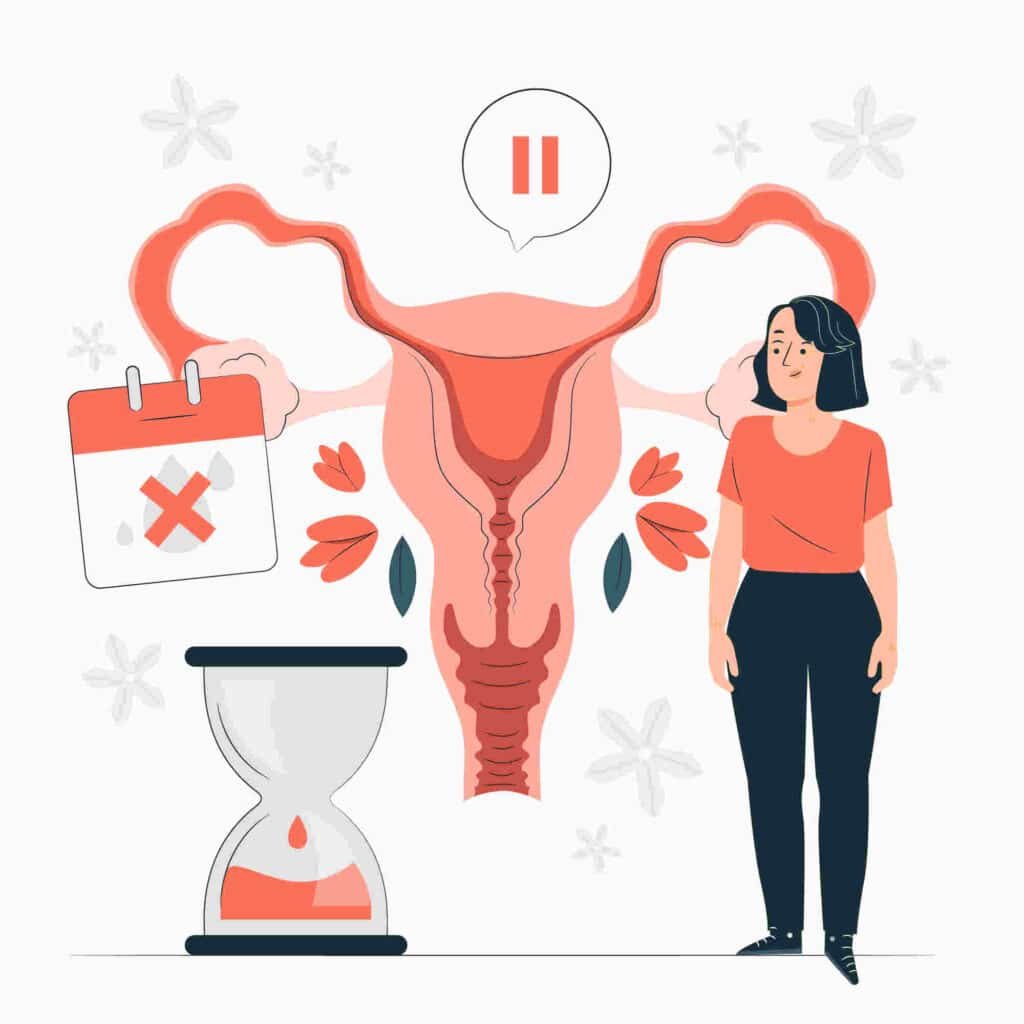
Each phase, follicular, ovulation, luteal, and menstruation, shifts estrogen levels, progesterone levels, follicle-stimulating hormone (FSH), and gonadotropin-releasing hormone (GnRH). These hormonal changes affect:
- Energy levels (higher in the follicular phase, lower in the luteal phase)
- Glucose tolerance and insulin resistance (better in the first half of the cycle)
- Mood swings and PMS symptoms (often worse before menstruation)
- Fat burning and weight loss efficiency
A 2022 study in Frontiers in Endocrinology found that women’s bodies respond differently to fasting than men’s due to fluctuations in female sex hormones. Extreme calorie restriction can disrupt the reproductive cycle, leading to irregular periods or amenorrhea.
Intermittent Fasting and Your Menstrual Cycle
For women, intermittent fasting is more than skipping meals, it’s about aligning with your body’s natural rhythm. That rhythm? It’s your menstrual cycle. Ignoring it can be the very reason fasting leaves you feeling drained, moody, or hormonally off balance. Unlike men, whose hormone levels remain relatively steady, women experience a monthly symphony of hormonal fluctuations that influence everything from calorie needs and insulin sensitivity to stress resilience and fat storage.
Key reproductive hormones like estrogen, progesterone, luteinizing hormone (LH), follicle-stimulating hormone (FSH), and gonadotropin-releasing hormone (GnRH) rise and fall throughout the cycle, affecting your appetite, energy levels, mood, and metabolism.

That means the same fasting regimen that works for one person may not suit another, especially if menstrual irregularities or hormonal imbalances are in play. The goal isn’t just to pursue weight loss, but to support overall health, menstrual health, and reproductive hormones sustainably.
How Intermittent Fasting Affects the Menstrual Cycle
1. Hormonal Changes & Potential Risks
The menstrual cycle is governed by a sensitive hormonal orchestra involving estrogen and progesterone levels, follicle-stimulating hormone (FSH), luteinizing hormone (LH), and gonadotropin-releasing hormone (GnRH). These hormones don’t just control ovulation and menstruation, but also influence insulin sensitivity, energy levels, fat storage, and mood.
Here’s how intermittent fasting can impact these systems:
Raised cortisol levels: Fasting for extended periods, especially without enough calorie intake, can elevate cortisol levels, the body’s main stress hormone. High cortisol can suppress reproductive hormones, leading to irregular periods, longer periods, or even menstrual irregularities such as hypothalamic amenorrhea (missing periods altogether).
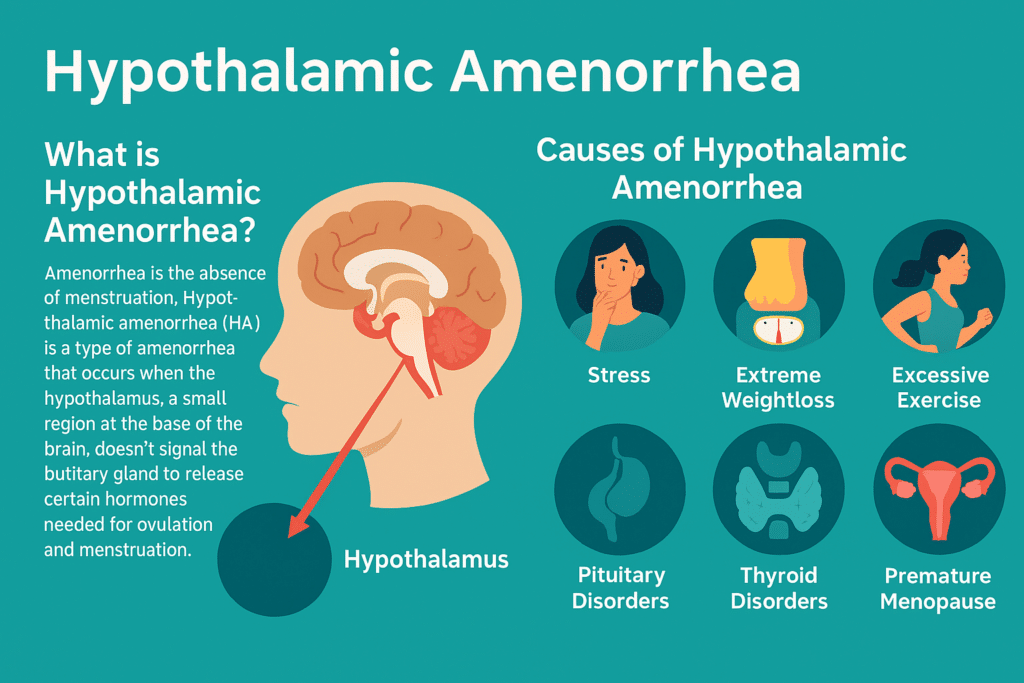
For more insights on how cortisol impacts weight, refer to this blog – Can Intermittent Fasting Cause Weight Gain – 7 Shocking Reasons
Reduced estrogen levels: Since estrogen plays a key role in maintaining uterine lining, bone health, and metabolic function, a drop caused by prolonged fasting can disrupt menstrual health, making periods lighter, delayed, or absent.
Disrupted ovulation: A recent study showed that GnRH secretion can be inhibited when calorie restriction or extreme fasting is sustained. Without proper GnRH signaling, ovulation may not occur, impacting reproductive health and even potential pregnancy.
2. Benefits of Fasting for Women – The flip side
Let’s be clear, intermittent fasting isn’t just about skipping breakfast or chasing a number on the scale. For women, especially those navigating the ebbs and flows of hormonal shifts, fasting can become a powerful ally when done in rhythm with the menstrual cycle phase.
From weight loss and fat burning to hormone balance and emotional clarity, the effects of intermittent fasting on a woman’s body are profound, but only when it respects her unique biology.
Weight Loss & Fat Burning, The Smarter Way
Yes, weight loss and fat burning are real outcomes of intermittent fasting, but there’s more to the story.
During fasting periods, insulin sensitivity improves, helping your body regulate blood sugar levels more effectively. This means less fat is stored, especially around the abdomen, making belly fat easier to lose. When fasting is aligned with the follicular phase (the first half of your menstrual cycle), your body is especially efficient at using fat for fuel, due to rising estrogen and a natural uptick in glucose tolerance.
To delve deeper into the benefits of clean fasting, check out this blog. – Clean Intermittent Fasting – 5 Proven Benefits for Fat Loss & Health
Women who fast in sync with their cycles tend to experience more sustainable fat loss and fewer side effects compared to those following rigid fasting schedules year-round.
Mental Clarity & Emotional Balance
The effects of intermittent fasting go far beyond the physical. By supporting autophagy, your brain’s natural clean-up process, fasting clears out damaged cells and encourages renewal. This translates into sharper focus, more balanced moods, and better memory. It’s especially helpful for women who feel overwhelmed or emotionally scattered during the luteal phase, when progesterone rises and PMS symptoms peak.
For supplements that can enhance mental clarity during fasting, refer to this blog. 10 Best Supplements for Intermittent Fasting
Fasting has also been shown to boost BDNF (brain-derived neurotrophic factor), a key protein that supports brain health and emotional resilience.

Hormonal Health & PCOS Support
Many women today are dealing with hormonal imbalances, whether it’s irregular periods, polycystic ovary syndrome (PCOS), or estrogen dominance. Fasting can help.
By improving insulin sensitivity, fasting directly reduces one of the main drivers behind PCOS: elevated insulin and androgen levels. As insulin levels stabilize, hormonal harmony is gradually restored, leading to more regular cycles and improved fertility.
Study highlight: A review in Reproductive Biology and Endocrinology revealed that women with PCOS who practiced intermittent fasting saw better hormonal balance, reduced symptoms, and more consistent ovulation, all without relying on medication.
Stronger Metabolic Health
Intermittent fasting is a metabolic reset for women, especially when synced with their menstrual cycle phase.
It improves key indicators of metabolic health, like:
- Glucose tolerance
- Blood sugar levels
- Blood pressure
- Reduced inflammation
For women, especially during the menstruation and luteal phases, when fatigue and bloating are common, fasting gives the body space to repair, restore, and regulate. These improvements are particularly helpful for women who are insulin resistant or prediabetic.
More Energy, More Confidence
Fasting isn’t just about willpower. It’s about listening to your body.
When women fast wisely, honoring hunger signals, choosing nutrient-dense meals during eating windows, and adapting to their menstrual cycle phase, they often experience more energy, not less. That’s because the body becomes more metabolically flexible, efficiently switching between burning glucose and fat as fuel.
Plus, there’s an emotional shift too: less guilt, fewer cravings, and more confidence in your ability to take care of yourself.
“There’s freedom in knowing you don’t need to eat every few hours to feel okay. You’re in tune with your body, and that’s a kind of strength no diet can give you.”
Fasting with Your Cycle – A Step-by-Step Guide
Intermittent fasting works best when it respects the natural rhythm of a woman’s menstrual cycle. While men have relatively stable hormone levels, a woman’s body shifts every few days, responding to changing estrogen, progesterone, FSH, and GnRH levels. These fluctuations affect everything from mood and energy to fat storage and insulin sensitivity. Learning to fast in sync with your cycle is key to balanced hormones, effective fat loss, and better menstrual health.
1. Follicular Phase (Day 1–14): Prime Time for Fat Burning
What’s happening: Estrogen rises, FSH stimulates the ovaries, and the uterine lining begins to rebuild. This phase starts on the first day of your period and continues until ovulation.
Why it’s a good time to fast: Estrogen enhances insulin sensitivity and glucose tolerance, making this the ideal window for longer fasts (14–16 hours). Energy levels are higher, and your body is more resilient to calorie restriction.
Best fasting strategy: Embrace longer fasts with confidence. Your body is primed for metabolic benefits during this phase.
To see what results you might expect, read this blog. – Intermittent fasting results in weight loss – 7 Days to a New You
What to eat: Support your hormones with leafy greens, lean proteins, seeds, and healthy fats like avocado and olive oil. These nourish estrogen production and stabilize blood sugar.
For guidance on what to drink during fasting, refer to this blog. – What to Drink During Intermittent Fasting – 3 Best Drinks for Fat Burning & Hydration
Key tip: Start your intermittent fasting cycle here, your body is ready and will thank you with improved fat burning and mental clarity.
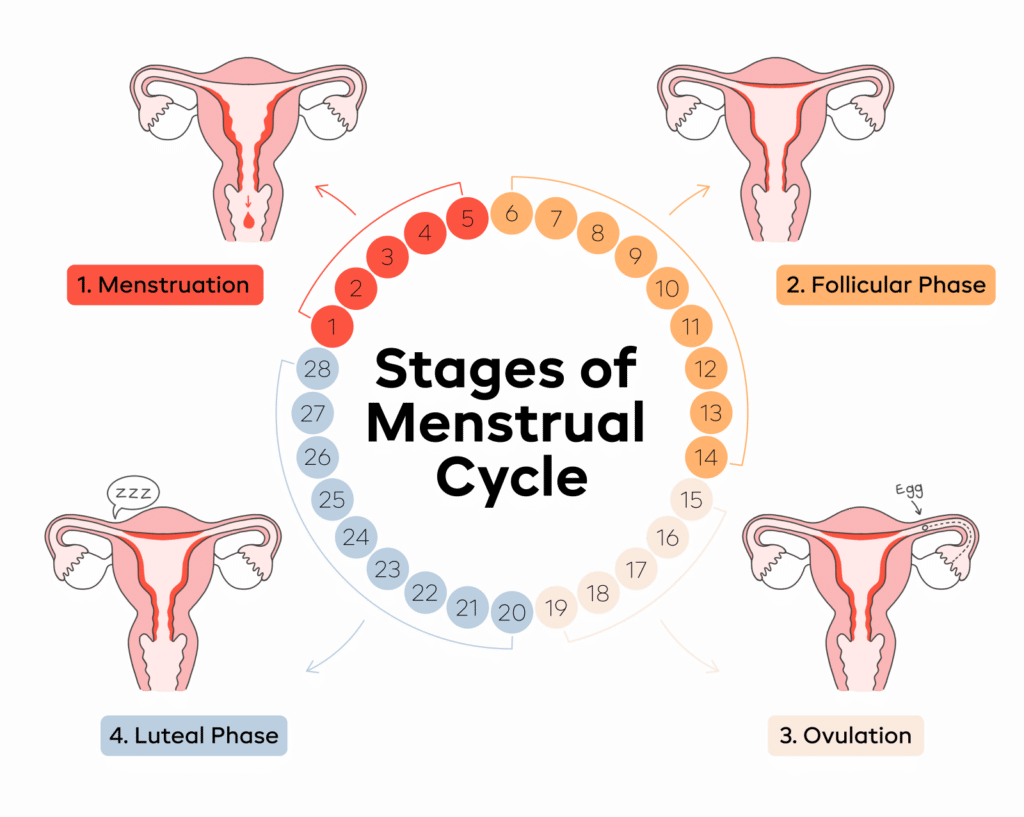
2. Ovulation (Around Day 14): Stay Balanced
What’s happening: Estrogen peaks, and the body prepares for possible fertilization. LH surges to trigger ovulation.
Why caution helps: You may feel energized and social, but excessive fasting or stress can elevate cortisol, which can disrupt ovulation and reproductive health.
Best fasting strategy: Moderate fasting (12–14 hours) works best. Your body is still insulin sensitive but needs support rather than depletion.
What to eat: Focus on magnesium-rich foods—pumpkin seeds, leafy greens, and almonds—to support progesterone and reduce stress.
Note: While you might feel unstoppable, don’t push too hard. Nourish your body and avoid heavy fasting that can interfere with hormonal balance.
3. Luteal Phase (Day 15–28): Time to Slow Down
What’s happening: Progesterone rises after ovulation. You may experience cravings, lower energy, mood shifts, and bloating.
Why shorter fasts are better: High cortisol during this phase can suppress reproductive hormones. Gentle fasting (12 hours or less) reduces stress on the body and prevents hormonal disruptions.
Best fasting strategy: If you fast at all, keep it short and flexible. This isn’t the time to aim for weight loss at the expense of balance.
What to eat: Incorporate complex carbs, root vegetables, and whole grains to support serotonin and ease PMS. Magnesium-rich foods help reduce cramps and soothe the nervous system.
Tip: It’s okay to take a break. Your body needs calories to produce progesterone and maintain hormonal balance.
4. Menstruation (Day 1–5 of Next Cycle): Rest and Rebuild
What’s happening: Estrogen and progesterone drop, triggering your period. The body focuses on repair and renewal.
Why fasting should be gentle: This is a time of physical stress. Long fasts can worsen fatigue and hormonal imbalances.
Best fasting strategy: Skip fasting or keep it to 12 hours max. Focus on rest, hydration, and nourishing foods.
What to eat: Prioritize iron-rich foods like lentils and spinach, paired with vitamin C for absorption. Omega-3s help ease cramps and reduce inflammation.
Reminder: Your body is doing vital work. It’s okay to pause fasting and focus on self-care and healing.
Syncing with Your Cycle: The Smarter Way to Fast
The benefits of intermittent fasting vary, especially for women. The key is flexibility, and what intermittent fasting schedule you choose. When you fast with your menstrual cycle in mind, you work with your hormones instead of against them. This means fewer side effects, more sustainable weight loss, and better emotional and hormonal health.
Track your cycle, listen to your body, and adapt your intermittent fasting plan accordingly. This approach supports hormonal balance, menstrual health, and long-term well-being.
A 2023 study in Nutrients found that women who adjusted their fasting regimen based on their menstrual cycle experienced fewer side effects like fatigue and irregular periods.
Building the Right Intermittent Fasting Plan for Women
Every woman is different, and so are her hormonal rhythms, lifestyle, and wellness needs. That’s why finding the right intermittent fasting schedule for women is less about copying trends and more about aligning with what your body actually needs. Here’s a look at the most popular fasting schedules and how to tailor them to your cycle, health condition, and lifestyle.
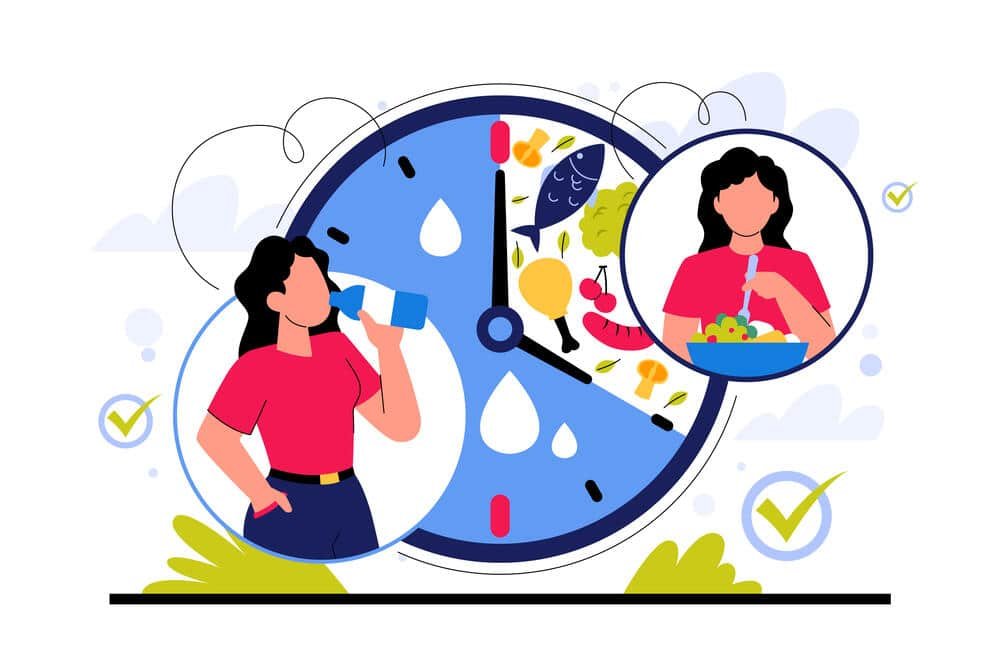
Best Intermittent Fasting Schedules for Women
| Method | How It Works | Best For |
| 16:8 Method | Fast for 16 hours, eat during an 8-hour window (e.g., 12 pm to 8 pm). | Women with stable menstrual cycles and balanced hormones. |
| 5:2 Method | Eat normally for 5 days a week. For 2 non-consecutive days, reduce intake to 500–600 calories. | Women who prefer flexibility without daily fasting. |
| Cycle-Synced Fasting | Adjust fasting based on your menstrual cycle phase—fast less during the luteal phase and more during the follicular phase. | Women with hormone imbalances, PMS, or PCOS. |
| 12:12 Method | A gentle introduction: 12 hours of fasting, 12 hours of eating. | Beginners or women who are sensitive to longer fasts. |
| Alternate Day Fasting (modified) | Eat every other day but consume about 500 calories on fasting days. | It may suit women with insulin resistance (under medical guidance). |
Start slow. Allow your body to adapt before jumping into longer fasting windows. Hormones need time to adjust, and sudden changes may trigger stress responses, especially in women.
Who Should Avoid Intermittent Fasting?
While intermittent fasting can be a powerful tool for weight management, hormone regulation, and longevity, it isn’t right for every woman. Here’s when you should pause and reconsider, or at least speak with a doctor first:
If you have hypothalamic amenorrhea (missing periods), Fasting can further disrupt hormonal signals. Nutrient intake and regular meals are vital for recovery.
High cortisol levels or adrenal fatigue: Fasting is a form of stress. When your stress hormones are already elevated, it may do more harm than good.
Potential pregnancy or during pregnancy: Your body needs consistent fuel for hormone production and fetal development.
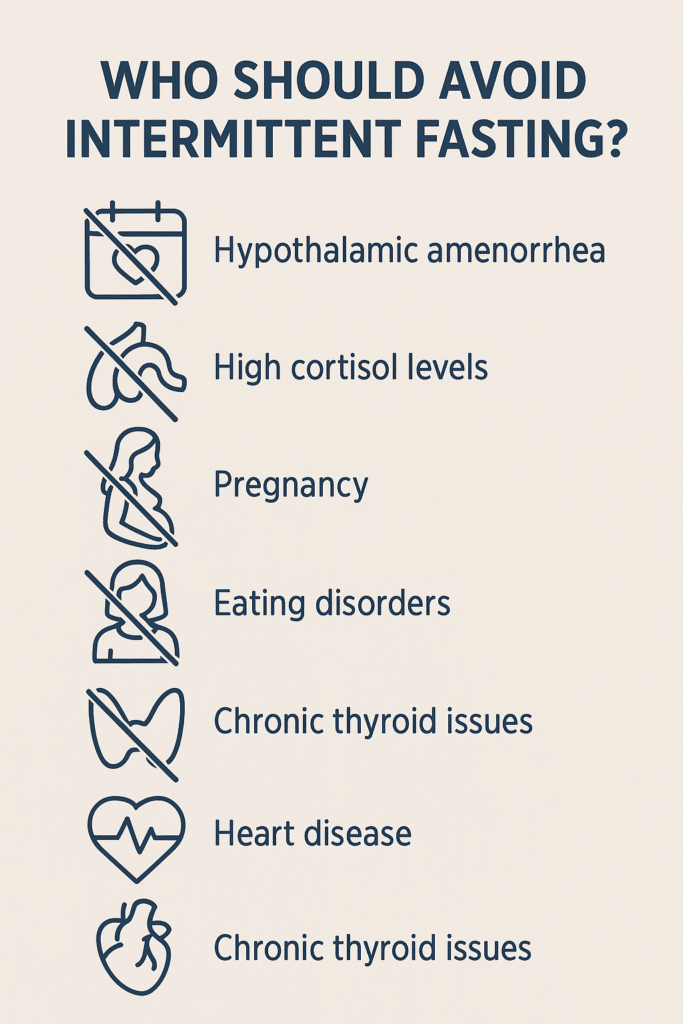
History of eating disorders: Fasting can be triggering. Emotional and psychological healing must always take priority.
Chronic thyroid issues or PCOS: While fasting might benefit insulin sensitivity, it can worsen symptoms if done without guidance. Always work with a functional or integrative health practitioner.
Heart disease or cardiovascular risk: Women with existing heart conditions should avoid unsupervised fasting. Sudden changes in eating patterns can affect blood pressure, electrolyte balance, and cardiac stress levels.
Just because something works wonders for someone else doesn’t mean it will for you. Intermittent fasting for women must be intuitive, hormone-friendly, and flexible.
Always consult a healthcare provider before starting, especially if you have PCOS, thyroid issues, or other medical conditions.
The Best guide for every woman in the world – By Patricia Nestor
Ever feel like your body isn’t cooperating with your health goals? It’s not your fault, it’s your hormones! Intermittent Fasting for Women is the game-changing guide designed to sync with your unique biology, helping you overcome weight loss plateaus, boost energy, and regain hormonal balance. Whether you’re navigating the ups and downs of your cycle, tackling stress, or looking for a sustainable way to feel good in your skin, this book offers a science-based approach that respects your body’s needs at every stage of life. Forget the generic advice, this is fasting tailored for YOU. Ready to break free from the frustration?
Start now and feel the difference; your body will thank you.
1. Why does my hunger feel more intense before my period, even when I’m fasting regularly?
Hormonal shifts, especially rising progesterone in the luteal phase, boost your appetite as your body prepares for a possible pregnancy. It’s completely normal to feel hungrier, and it doesn’t mean your fasting is failing. Listening to your body during this time is the smart move.
2. Is it okay to skip fasting on some days of my cycle if I’m feeling tired or moody?
Yes. Your body isn’t a machine. Fatigue, irritability, or low motivation during your period or luteal phase are signs you might need rest, not restriction. Fasting success comes from flexibility and self-awareness, not rigidity.
3. Will fasting affect my iron levels if I have heavy periods?
It can. If your eating window is too short or lacks iron-rich foods, fasting may worsen iron deficiency. Include lentils, spinach, red meat, or iron-fortified foods during meals, and consult your doctor about supplementation if you feel unusually tired or lightheaded.
4. Can intermittent fasting make my cramps worse?
For some, fasting reduces inflammation and eases cramps. For others, it may make things worse, especially if hydration or nutrient intake is low. If cramps intensify, ease up on fasting, stay hydrated, and consider adding magnesium-rich foods like dark chocolate, seeds, and leafy greens.
5. What if my cycle is irregular, and how do I sync fasting with it?
Start by tracking your energy, mood, and hunger daily, not just your period dates. Over time, your body will reveal its rhythm. You can tailor your fasting around how you feel, rather than relying solely on a calendar. Irregular cycles need more intuition, not more pressure.
Conclusion – Fast in Sync, Thrive in Health
Intermittent fasting can offer health benefits, but women’s bodies require a more nuanced approach than men’s. The right way to fast involves:
✔️ Syncing your fasting window with your menstrual cycle
✔️ Prioritizing nutritional needs (healthy fats, whole grains, magnesium)
✔️ Listening to your body, if you feel fatigued, adjust!
Your menstrual health is a barometer of overall health. Fasting should support, not to disturb your hormonal balance.
If you’re managing conditions like PCOS, thyroid imbalance, or heart concerns, be sure to listen to your body and consult a healthcare provider.
Begin your journey today: track your cycle, choose a fasting method that feels right, and take the first step toward sustainable, hormone-friendly health.
“Your cycle isn’t an inconvenience—it’s your compass. Work with it, not against it.”
Ready to try intermittent fasting? Start slow, track your cycle, and find what works for your body weight, energy levels, and menstrual health.

